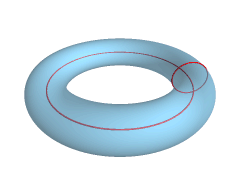|
(2015
midterm assignment) Model Student Midterm answers 2015 (Index) Essay 2: Personal / professional topic |
 |
Holly Williams
High-Tech Science Fiction Vs. Low-Tech Science Fiction in Literature
Upon entering my class of Literature of The Future, taught by Dr. White,
I have never examined the Science Fiction genre, nor have I ever had any
interest in this genre of fiction. I walked into this class completely blinded
of this particular genre and all it offers, which gave me an overwhelming start.
Admittedly, I have enjoyed a handful of the texts that I was required to read
that I did not expect to take my interest. Upon apprehending which texts I
enjoyed and which I did not enjoy (as much), I came across two topics that
defined my interest in each book;
high-tech science fiction and
low-tech science fiction. These two subgenres of science fiction literature
characterize each narrative I have read and shaped my perspective into which
ones I have enjoyed and which ones I had a hard time enjoying.
High-tech science fiction
features advanced technology and science that showcase the colossal jump in
technological features that we experience today. This type of science fiction
can be harder to digest to an amateur (like myself) of the genre. When a
narrative takes place so far into the future and utilizes colossal advances in
technology, the context can seem far fetched to the reader and harder to grasp.
Stone Lives is an example of a
high-tech science fiction novel,
taking place in the future where the technology advances are extreme and the
reader is learning along with the main character as they are reading. The
characters take on bionic characteristics that are so far from human nature such
as how June’s channels in her body are “filled with synthetic luciferase, the
biochemical responsible for the glow of fireflies, which she can trigger now at
will” (Filippo, 1985). This type of
high-tech science fiction falls under a subgenre category called
cyberpunk. Cyberpunk often centers on
artificial intelligences and megacorporations that tend to be set in a far
future. Another narrative that takes on this persona is
Somebody Up There Likes Me set in the
future where the technology has taken a massive leap with the computer the
Revelation 2000 that was “the first microcomputer with a holographic screen,
1000-bit audio/video, three billion instructions per second, and direct wireless
uplink to geosynchronous satellites” (Lombreglia). These stories that take on
this cyberpunk characteristics are
harder for some readers to follow along with compared to
low-tech science fiction literature.
Low-tech science fiction
literature takes on different characteristics based on social sciences such as
psychology, economics, political science, sociology, and anthropology. These
type narratives tone down the technological advances and have a more realistic
appeal to them. Such as in the story
Parable of the Sower where Lauren’s world is slowly deteriorating and she
has to adapt to survive. This type of narrative is a story that readers can
relate and connect with, therefore increasing their interest in the story. These
type stories are easier to digest for some readers compared to
high-tech stories that involve
far-fetched realities. The Time Machine
is another low-tech story because
the future stems from social issues happening in today’s world where you have
the huge gap between the rich and the poor. I agree with Tanya Partida when she
says, “while only a matter of opinion, low-tech stories that have limited
descriptive elements of science and technology kept within a larger concept or
idea always seem to work better in getting its message across” (Partida, 2011).
These type stories appeal to most readers because they can associate with the
issues happening in the story. These stories were the ones I found most
interesting really enjoyed reading!
Going into the education field, a teacher is given a classroom full of
diverse children with diverse knowledge and experiences. Knowing the difference
between high-tech and
low-tech science fictions stories is
essential when choosing what books to offer in the classroom. Some students may
identify easier with low-tech, while
others may have interest in high tech
science fiction literature. A teacher should also keep in mind the moral of the
story when choosing books into the classroom. Meeting the needs of every student
is a fundamental concept in the classroom and this is better done when
diversifying the literature the teacher offers in the classroom.
As a student newly introduced into the science fiction literature genre,
I am still learning all that I can about this genre. Dr. White has opened my
eyes to all the possibilities this genre can offer and has opened my perspective
into this new topic of the future with a mix of science and fiction
contributions. The narratives read in class have stood the test of times because
of their literary appeal and rich content. I’ve learned that with the
high-tech stories, the stories that
uphold through history are the ones who still remain
high-tech through this
technologically advancing world. The writers who have ever so creatively painted
a picture of the picturesque world in which has not yet happened, keep the
imagination going. The low-tech
stories that remain popular through history are the ones that stem from real
world social issues in which the reader can identify with and relate. These
novels will always appeal to readers that can connect with the real world.
 |
 |
 |
